问题1.找到三角形的顶点面积为:
(i)(2、3),(-1、0),(2,-4)
解决方案:
Area = 1/2 [x1(y2 – y3) + x2(y3 – y1) + x3(y1 – y2)]
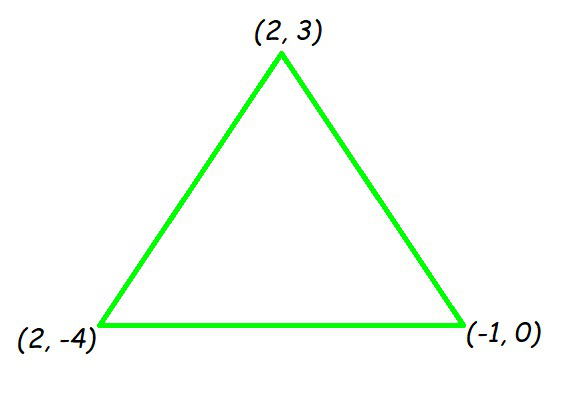
Now by putting all the values in the formula, we will get
Area of triangle = 1/2 [2(0 – (-4)) + (-1)((-4) – (3)) + 2(3 – 0)]
= 1/2 [8 + 7 + 6]
= 21/2
So, the area of triangle is 21/2 square units.
(ii)(-5,-1),(3,-5),(5、2)
解决方案:
Area = 1/2 [x1(y2 – y3) + x2(y3 – y1) + x3(y1 – y2)]
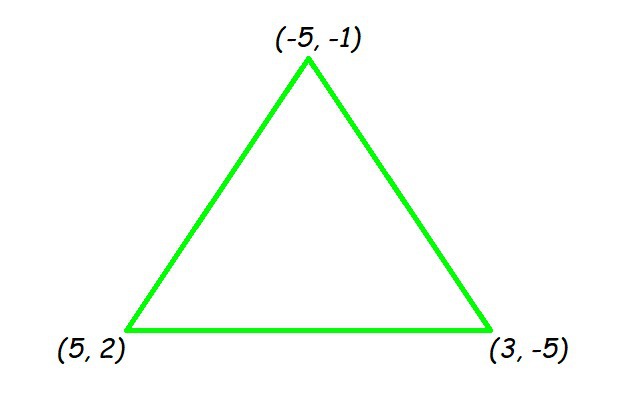
Area of the triangle = 1/2 [(-5)((-5) – (2)) + 3(2 – (-1)) + 5((-1) – (-5))]
= 1/2[35 + 9 + 20]
= 32
So, the area of the triangle is 32 square units.
问题2.在以下每个中,找到点为共线的’k’值。
(i)(7,-2),(5,1),(3,-k)
解决方案:
As we know the result, for collinear points, area of triangle formed by them is always zero.

Let points (7, -2) (5, 1), and (3, k) are vertices of a triangle. (As given in the question)
Area of triangle = 1/2 [7(1 – k) + 5(k – (-2)) + 3((-2) – 1)] = 0
7 – 7k + 5k +10 -9 = 0
-2k + 8 = 0
k = 4
(ii)(8、1),(k,-4),(2,-5)
解决方案:
As we know the result, for collinear points, area of triangle formed by them is zero.

So we can say that for points (8, 1), (k, – 4), and (2, – 5), area = 0
1/2 [8((-4) – (-5)) + k((-5) – (1)) + 2(1 -(-4))] = 0
8 – 6k + 10 = 0
6k = 18
k = 3
问题3。找到通过合并顶点为(0,-1),(2,1)和(0,3)的三角形边的中点而形成的三角形的面积。求出该面积与给定三角形面积之比。
解决方案:
Let us assume that vertices of the triangle be A(0, -1), B(2, 1), C(0, 3).
Let us assume that D, E, F be the mid-points of the sides of triangle.
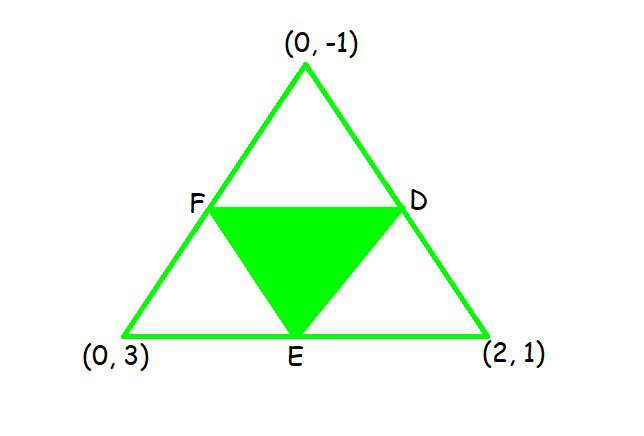
Coordinates of D, E, and F are
D = ((0 + 2)/2, (-1 + 1)/2) = (1, 0)
E = ((0+ 0)/2, (-1 + 3)/2) = (0, 1)
F = ((2+0)/2, (1 + 3)/2) = (1, 2)
Area(ΔDEF) = 1/2 [1(2 – 1) + 1(1 – 0) + 0(0 – 2)] = 1/2 (1+1) = 1
Area of ΔDEF is 1 square units
Area(ΔABC) = 1/2 [0(1 – 3) + 2(3 – (-1)) + 0((-1) – 1)] = 1/2 [8] = 4
Area of ΔABC is 4 square units
So, the required ratio is 1:4.
问题4。找出四边形的面积,其顶点顺序依次为(-4,-2),(-3,-5),(3,-2)和(2、3)。
解决方案:
Let the vertices of the quadrilateral be A(-4, -2), B(-3, -5), C(3, -2), and D(2, 3).
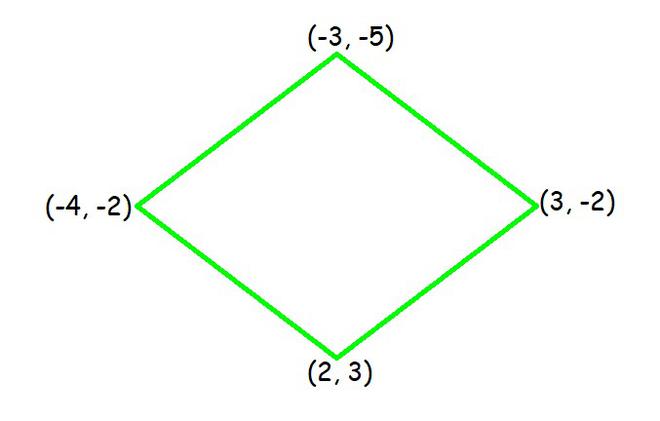
Here, AC divide quadrilateral into two triangles.
Now, we have two triangles ΔABC and ΔACD.
Area of ΔABC = 1/2 [(-4)((-5) – (-2)) + (-3)((-2) – (-2)) + 3((-2) – (-5))]
= 1/2 [12 + 0 + 9]
= 21/2 square units
Area of ΔACD = 1/2 [(-4)((-2) – (3)) + 3((3) – (-2)) + 2((-2) – (-2))]
= 1/2 [20 + 15 + 0]
= 35/2 square units
Now we will add area of both triangle and resultant will give area of quadrilateral
Area of quadrilateral ABCD = Area of ΔABC + Area of ΔACD
= (21/2 + 35/2) square units = 28 square units
问题5。您在IX类中研究了一个三角形的中位数,将其分成两个相等面积的三角形。对于顶点为A(4,-6),B(3,-2)和C(5,2)的ΔABC验证此结果。
解决方案:
Let the vertices of the triangle be A(4, -6), B(3, -2), and C(5, 2).
Let us assume that D be the mid-point of side BC of ΔABC. So, AD is the median in ΔABC.
Coordinates of point D = Midpoint of BC = (4, 0)
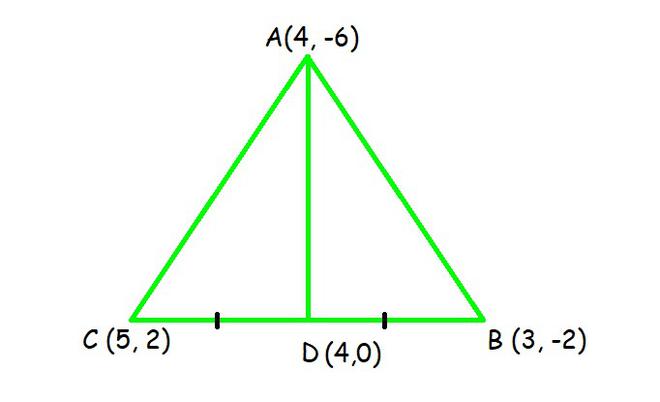
Formula: Area = 1/2 [x1(y2 – y3) + x2(y3 – y1) + x3(y1 – y2)]
Now,
Area of ΔABD = 1/2 [(4)((-2) – (0)) + 3((0) – (-6)) + (4)((-6) – (-2))]
= 1/2 [-8 + 18 – 16]
= -3 square units
As we know that, area cannot be negative. So, the area of ΔABD is 3 square units.
Area of ΔACD = 1/2 [(4)(0 – (2)) + 4((2) – (-6)) + (5)((-6) – (0))]
= 1/2 [-8 + 32 – 30]
= -3 square units
As we know that, area cannot be negative. So, the area of ΔACD is 3 square units.
The area of both sides is same.
So we can say that, median AD has divided ΔABC in two triangles of equal areas.